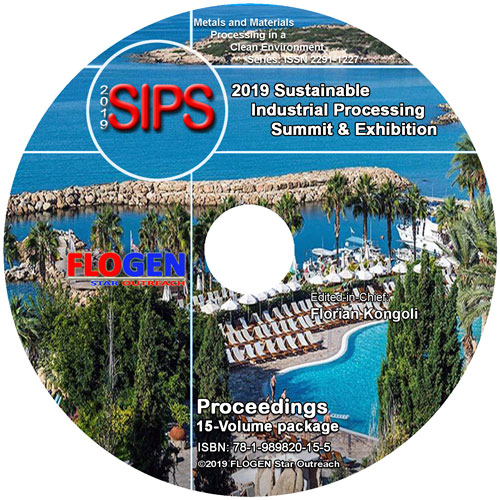2019-Sustainable Industrial Processing Summit
SIPS2019 Volume 6: Parameswaran Intl. Symp. / Sustainable Mining and Smelting
| Editors: | F. Kongoli, G. Baiden, D. Dzombak, L. Guo, L. Liu, M. Poulton, P. Somasundaran |
| Publisher: | Flogen Star OUTREACH |
| Publication date: | 20 December 2019 |
| Pages: | 95 pages |
| ISBN: | 978-1-989820-05-6 |
| ISSN: | 2291-1227 (Metals and Materials Processing in a Clean Environment Series) |

CD shopping page
The Application of Green Chemistry SuperLig® Molecular Recognition Technology and Other Sustainable Processes at Copper Electrorefineries
Luis Navarro1; Roberto Navarro-Tovar2; Ronald Bruening1; Reed Izatt1;1IBC ADVANCED TECHNOLOGIES, American Fork, United States; 2INSTITUTO TECNOLOGICO DE CELAYA, Celaya, Mexico;
Type of Paper: Regular
Id Paper: 450
Topic: 4
Abstract:
Copper prices are determined by world supply and demand. The increasing demand for a higher quality refined copper product from ores containing as little as 0.5% copper; varying levels of valuable constituents such as gold, silver, platinum group metals, nickel, selenium and tellurium; and potentially destructive impurities such as arsenic, antimony, lead and bismuth provide the impetus for researching, developing and implementing innovative process technologies in several areas within the copper electrorefining operation.
Recent technological innovations have allowed companies to reduce inefficiencies (e.g., energy consumption, waste generation) and unit costs while meeting increasingly stringent environmental, safety, and health regulations. One promising approach is the adoption of processes incorporating green chemistry, which is defined as “the design of chemical products and processes to reduce or eliminate the generation of hazardous substances.†It has become evident that incorporation of green chemistry principles into innovative process development has helped support investment decisions for these new processes.
This paper presents several examples of green chemistry technologies which have been implemented at copper electrorefineries, including (1) use of SuperLig® Molecular Recognition Technology (MRT), a highly selective technology capable of achieving loading to elution ratios of more than 40 bed volumes (BV) and flowrates above 0.2 BV/minute, in controlling antimony and bismuth concentration levels in copper electrolyte and for the separation of platinum group and other metals in electrorefining; (2) the recovery of sulfuric acid and arsenic in electrolyte purification using acid purification technology via an acid purification unit (APU®) in comparison to the conventional liberator cell (electrowinning) process; (3) recovery of tellurium from copper anode slimes initially through a cementation process followed by alkaline leaching, and (4) recovery of metals such as lead and nickel in electrolyte purification using a selective two-step alkaline precipitation.
Keywords:
Copper; Engineering; Leachates; Platinum; Recovery; Sustainability; Technology;References:
[1] Anastas, P., Eghbali, N., Chemical Society Reviews, 39, (2010) 301-312.[2] Artzer, A., Moats, M.. Bender, The Journal of the Minerals, Metals & Materials Society 70, (2018) 2033-2040.
[3] Izatt, R. M., Izatt, S. R., Izatt, N. E., Krakowiak, K. E., Bruening, R. L., Navarro, L., Green Chemistry 17, (2015) 2236-2245.
[4] Navarro, L., Morris, T., Read, W, Parameswaran, K., in Metal Sustainability: Global Challenges, Consequences and Perspectives, R.M. Izatt (ed.), John Wiley & Sons, Chichester, U.K., (2016) 397-423.
[5] Parameswaran, K. in the Proceedings of the 58th Annual Conference of Metallurgists (COM) hosting the 10th International Copper Conference 2019, MetSoc, Vancouver, August 18-21, 2019.
[6] Wang, S., Izatt, N. E., Bruening, R. L., Navarro, L., Izatt, R. M., Izatt, S. R., in the Proceedings of the 58th Annual Conference of Metallurgists (COM) hosting the 10th International Copper Conference 2019, MetSoc, Vancouver, August 18-21, 2019.